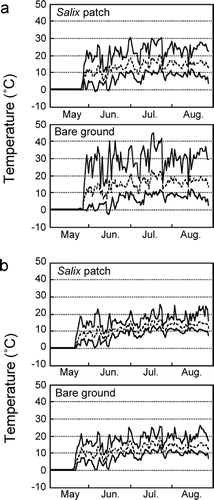Figures & data
TABLE 1 Abundance (number of individuals) and cover (% of ground surface area occipied by plant canopy) of species in plots A and B. All species were examined in plot A, and two dominant species in plot B.
FIGURE 1 Spatial analysis of the distribution pattern of six species in plot A (20 m × 20 m) and two species in plot B (25 m × 15 m). The plot of the derived statistic of Ripley's K-function [L(t) = [K(t)/π]1/2 − t] versus t reveals spatial patterns at increasing values of the neighbor's distance t. Positive values of L(t) indicate clumping and negative ones mean regularity. Dotted lines give 95% confidence intervals for complete spatial randomness from 1000 randomizations.
![FIGURE 1 Spatial analysis of the distribution pattern of six species in plot A (20 m × 20 m) and two species in plot B (25 m × 15 m). The plot of the derived statistic of Ripley's K-function [L(t) = [K(t)/π]1/2 − t] versus t reveals spatial patterns at increasing values of the neighbor's distance t. Positive values of L(t) indicate clumping and negative ones mean regularity. Dotted lines give 95% confidence intervals for complete spatial randomness from 1000 randomizations.](/cms/asset/f0f671f0-94bb-4380-bd03-498f566fbfcb/uaar_a_11957321_f0002.gif)
TABLE 2 Density at which species were found inside and outside of Salix patches. P values are from randomization test. The test was made for four abundant species in plot A, and for L. kaempferi in plot B.
FIGURE 2 Stem length (a), basal diameter (b), biomass (c), and root∶shoot ratio (d) of 0-, 1-, 3-, 5- and 6-year-old Larix individuals inside and outside Salix patches. Mean and SE are displayed in each panel (n = 8 to 20). Significant differences between microhabitats are shown by asterisks (ANOVA or Mann-Whitney U-test); *, P < 0.05; **, P < 0.01.

TABLE 3 Survivorship of L. kaempferi for 6 years inside and outside of Salix patches. Number of individuals in 1999, survivors in 2005, and survival ratio are shown for individuals in two age classes and all individuals. Differences in the survival rate between inside and outside of patches are tested by Fisher's exact probability test.
FIGURE 3 Seasonal changes in daily cumulative photosynthetically active photon flux density (PPFD) on the soil surface in the Salix patches and bare site. The upper solid line indicates the data in bare site, and the broken line and lower solid line indicate the data in the patches, respectively.

FIGURE 4 Seasonal changes in the soil-surface temperatures (a) and belowground temperatures (b) in the Salix patches and bare ground. Daily maximum and minimum temperatures are shown by upper and lower solid lines, respectively. Daily means are shown by broken lines.

TABLE 4 Water and nitrogen contents and stability of ground surface substratum in Salix patches and bare ground. Mean ± SE are shown (n = 6 for water and nitrogen contents and n = 15 for the stability of surface scoria).